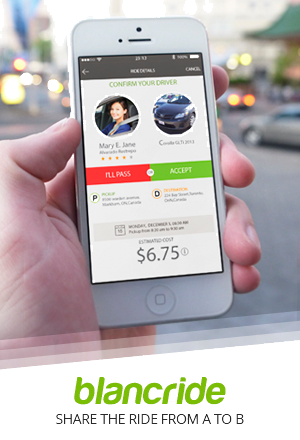March 8, 2015 – I got an email from a Toronto start up a few days ago telling me about a new smartphone app the company had created that takes Uber one step further. Uber is a headline-making disruptive alternative to the taxi industry that in many cities is leading to all types of controversy. Taxi companies are up in arms and some cities have even attempted to ban the smartphone application.
Blancride takes a different approach to hitching a ride. In a press release it justifies the reason for its existence by stating the following: “In Canada, over 83% of the commuter population drives alone, which results in 2.5 billion one-person cars leaving 10 billion empty seats.” The release goes on to state that Blancride is the answer by providing a community-service alternate model to car pooling.
When I was in university and driving my first car I ran a car pool. It helped me pay for my gasoline and parking down at the university and I was able to get a number of other students to ride along with me. It was workable but a bit messy. I had to drive out of my way to pick up my passengers. And at the end of the school day I often had to wait before going home to meet the schedule of those in my pool.
Blancride eliminates the going out of your way for the driver and the time delays. Drivers who download the app make themselves available to offer rides along an indicated route. Passengers seeking a ride are matched to the route and timing of the driver’s trip. The app notifies both passenger and driver and posts the price for the ride. Driver and passengers confirm the link up. At the appointed time the driver picks up the passenger and confirms this through the app. When the passenger reaches his or her destination Blancride handles payment putting the money directly into the driver’s registered bank account. It’s that simple.
Blancride may be more expensive than public transit but it is a fraction of the cost of taking a cab. A driver can pick up several passengers who are along the route. The driver is never inconvenienced by having to go out of his or her way. The passengers don’t have to ride the bus or street-car or try and hail a cab. If it catches on the benefit for cities will be fewer cars on the road, another example of how wireless communications and smartphones are altering the way we live in the 21st century.











